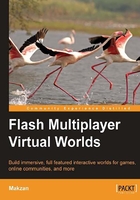
What this book covers
Chapter 1, Developing Flash Virtual World, discusses the benefit of developing a Flash virtual world. It also discusses different connection methods between Flash clients and compares different server solutions. You will also get introduced to the common features in a Flash virtual world such as avatar, home, items, quests, non-player characters, and others. You will also know about some existing virtual world games such as Club Penguin, Mole, Dofus, and World of Warcraft.
Chapter 2, Installing The Servers, develops and deploys a virtual world environment. You will also install the Java Development Kit and SmartFoxServer, connect it with MySQL server and configure the server settings. You will then load a simple chat application and set up and log in to the administration panel.
Chapter 3, Getting Familiar with SmartFoxServer, configures a Basic SmartFoxServer and discusses how to set up the Flash player to view the Flash trace log without the Flash IDE. You will also see how we can prevent the Flash loading data or connect sockets to other resources that are not in the same domain of the hosting server by using the Flash player's inbuilt security sandbox. You will also create a Flash document to connect the server and finally, create a whiteboard that every connected user can draw on and test it.
Chapter 4, Creating Map and Ground in Isometric View, compares different game views, create an isometric map, and a ground for the virtual worlds. You will then build a Map Editor, which will be used later for development.
Chapter 5, Creating Avatars, designs an avatar and draws the avatar in Flash. You will then customize your avatar with different styles and colors. You will also design and create a customization panel and finally, integrate it to the SmartFoxServer.
Chapter 6, Walking Around the World, covers the different methods to move the avatar in the virtual world. You will code your first server-side extension and create the connectivity between Flash client and the database.
Chapter 7, Creating Buildings and Environments in the Virtual World, teaches you how to place a building on the Map and order the buildings while displaying them. You will also create a map editor for the buildings.
Chapter 8, Creating an Inventory System, classifies items in the virtual world and also discusses about avatars collecting items. You will also learn about defining the data structure of an inventory item and implementing an inventory and an item panel.
Chapter 9, Communicating with Other Players, discusses the various methods for communicating in the virtual world which includes chatting with public messages. You will also learn how to implement a buddy list, add players to it, and finally send messages to these players. You will also see how we can share items between players.
Chapter 10, Interacting With NPC, shows how we can run a virtual world smoothly by introducing non-player characters. You will place your first NPC and control its movements. You will see the different communication methods available for the NPC and how to trade items with the NPC.
Chapter 11, Designing Quests, introduces quests and how they can be triggered in a virtual world. You will set up server environments for quests and design quest panels. You will also see how you can encourage players to participate in quests by placing rewards and improving the quests.
Chapter 12, Social Community, discusses the benefits of having a social networking feature in your virtual world. This chapter will show you how to integrate with the Facebook and the Twitter platforms.
Chapter 13, Deploying and Maintaining Flash Virtual World, shows how you can host the virtual world and operate the virtual world. You will also see some methods to earn money from virtual world. You will also learn to transfer your virtual world to mobile and other platforms such as Apple iOS and .NET and Unity, among others.